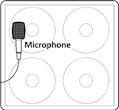This is the wiki for products made by Fractal Audio Systems, maintained by members of the community.
November 2025: the entire wiki has been updated with information about the new AM4 amp modeler.
Speakers and microphones
About microphones

Impulse responses are captured using microphones.
"Using a "neutral" IR with a simulated mic does not sound the same as an IR using that mic. It simply can't. Neutral mics like the Earthworks TC series are nearly omnidirectional. They operate by using a very small aperture as compared to traditional mics that have effective apertures orders of magnitude bigger." source
"The mic I've been most impressed with for recording guitar lately is the Beyer M160. I don't like SM57's alone for amps. They're too spikey and compressed but mixed with an M160 or R121 they add some nice sizzle." source
"The M160 is an awesome guitar cab mic. All the IRs we got with the M160 came out really nice." source
"My typical workflow is to choose an R121 or M160 first as these have the best low end. Then I choose an IR from one of the other mic types to get the desired brilliance. This is usually an SM57 or 4047. I just don't like 906s or 414s but that's me. I leave the panning at default but that's just my preference." source
"If you get a chance try a Shure KSM313, an AEA R84 and a Beyer M160. The KSM313 is now my preferred mic for guitar cabs. I like it better than the R121. I find the KSM313 a little more balanced. The R121 has a lot of bass and proximity effect and the high end can be a little dull." source
"My favorite mic for guitar cabs is the KSM313." source
"Certain mics like the royer 121 have 2 sides (front, back). Each has a different sound. Back side of the R121 is a bit darker. The difference between the front in the back is only apparent at closer mic distances. Get out past 3 feet and the sound the same on either side."
"My standard technique is to use a couple ribbon mics (313, 160, 121) along with a 4047 and a 57 and adjust to taste. I rarely mix cabs, almost always using IRs from the same cab. The two ribbon mics and 4047 I blend equally, the 57 usually 6-12 dB down. Those Ownhammer IRs are good too, the ones w/ four different mics. Load all four and mix to taste." source
Dialing in Your Tone by Red Wirez provides useful info about mics and mic positioning.
Wikipedia:
Additional information about microphones:
- http://www.soundandrecording.de/tutorials/mikrofonvergleich-vor-dem-e-gitarrenverstaerker
- Wikipedia
- http://soundschematic.com/dynamic-ribbon-condensor
- http://www.barryrudolph.com/stellar/guitar.html
- http://www.gearslutz.com/board/so-much-gear-so-little-time/201972-mic-standards.html
- U67
- SM57
- SM58
- MD421
- U87
- D112
- Beyer M160, Beyer M160
- Wicked Wiki
About guitar speakers

Impulse responses reproduce the sound of a speaker cabinet. Here's some background information on guitar speakers.
- Speakers: the final frontier
- Legendary Tones: G12M versus G12H
- TGP: EVM 12L versus EVM 12S
- Sound On Sound: choosing guitar-amp speakers
- Sound on Sound: understanding and recording guitar speakers
- Rivera: 15 speakers compared (YouTube)
- Eminence tone guide
- Fenderguru: selecting speakers
- Celestion history
- Pre-Rola greenbacks explained, part 1
- Pre-Rola greenbacks explained, part 2
- Premier Guitar: how a speaker cabinet influcences your tone
- Leon Todd compares IRs of V30s
- Sound clips of Celestion speakers on SoundCloud
Jensen speakers:
- P12R: 12”, 15W
- P12Q: 12”, 20W
- P12N: 12”, 30W
- P10R: 12”, 15W
"Break-in is definitely real with guitar speakers. The surround is stiff when new due to the doping. I don’t think monitors and hifi speakers exhibit any significant break-in." source
"We witnessed speaker break-in first-hand when shooting IRs. We bought a brand-new 5150 III cabinet. Went to shoot some IRs and they sounded terrible. So I put the synth block on and ran the speaker for several hours while we were doing other stuff. Came back and shot some IRs and they were much better sounding." source